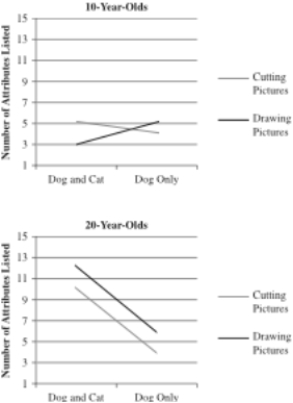Dr. Elder was interested in the way people recognize objects as members of categories. For example, what makes us recognize a dog as being a dog and not a cat? More specifically, he was curious as to whether people think about categories in a more complex way if they contemplate an "opposite" category first. For example, does a person think more differently about the category of "southern" if they are also thinking about the category of "northern"? He is also curious as to whether people categorize differently if they are exposed to category members compared with generating category members. Dr. Elder has four groups of participants (with 30 people in each group) . In Group A, participants were told to cut out pictures of dogs and cats from magazines. In Group B, participants were told to cut out pictures of just dogs from magazines. In Group C, participants were told to draw pictures of cats and dogs. In Group D, participants were told to draw pictures of just dogs. After doing this for 30 minutes, participants in all groups were asked to list the attributes that define the "dog" category. Having a higher number of attributes listed was considered to be an indication of thinking about the category in a more complex way.
Dr) Elder also is curious as to whether categorization happens similarly for children as it does for adults. As such, he recruits a group of 10-year-olds and a group of 20-year-olds to participate in the study. The results are below.
The addition of the new variable to Dr. Elder's study could be thought of as which of the following?
Definitions:
Journal Entries
A record of financial transactions in accounting, documenting the debit and credit effects on specific accounts.
Adjusting Journal Entries
Journal entries made in an accounting period to allocate revenue and expenses to the period in which they actually occurred.
Closing Journal Entries
Entries made at the end of an accounting period to transfer temporary account balances to permanent accounts and prepare for the next period.
Revenue In Advance
Income received by a company for goods or services that are to be provided in the future, also known as deferred revenue.
Q5: Characteristic signs of Parkinson's disease are _,slowness
Q10: Sleep deprivation can cause motor vehicle accidents
Q14: Excessive worrying that is experienced daily for
Q15: For his research methods class, Felipe plans
Q20: A sample is always a population.<br>A)more expensive
Q24: Benzodiazepines have a high degree of _
Q28: Dr. Lonsbary is a cognitive psychologist who
Q29: In developing a measure of "need for
Q30: How many subcategories of quantitative variables exist?<br>A)Two<br>B)Three<br>C)Four<br>D)Five
Q52: The principle of justice calls for a